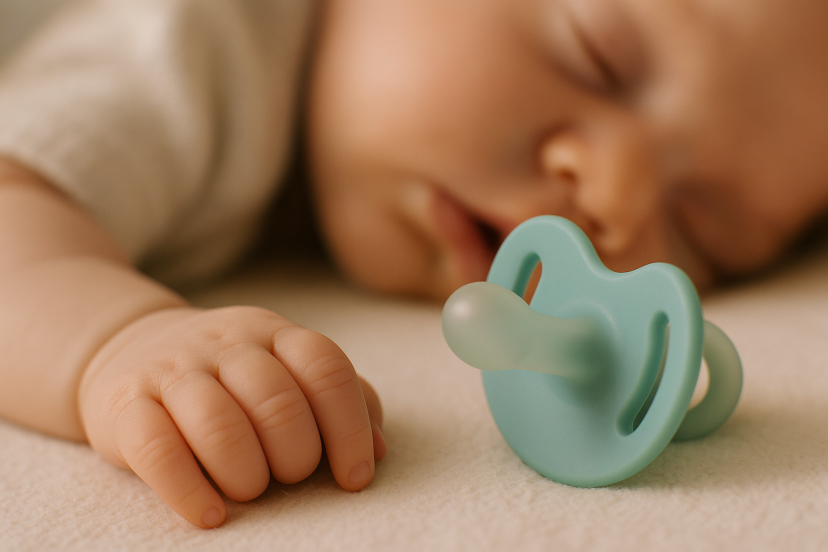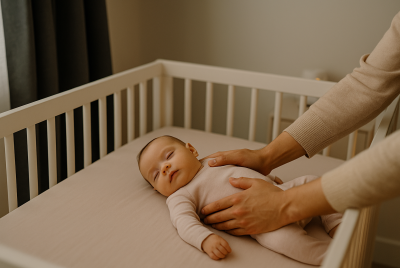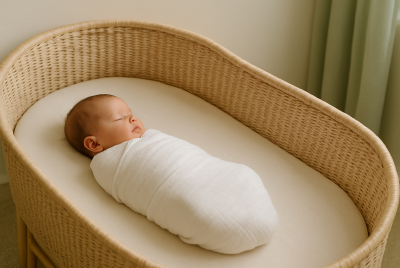Can a Newborn Sleep With a Pacifier? Safe Tips for Parents
We may earn a commission for purchases made using our links. Please see our disclosure to learn more.
You’re running on three hours of sleep, your newborn is doing that adorable-but-endless rooting-and-fussing routine, and you’re wondering… can a newborn sleep with a pacifier—and is it actually safe? Short answer: yes, with a few commonsense guidelines. In this no-judgment, parent-to-parent guide, we’ll unpack what the experts say, how to use a pacifier safely at night, how it may affect breastfeeding, and which pacifiers are worth a look. We’ll also share practical tips, mini checklists, and research-backed notes so you feel confident, calm, and ready for bed (you, too!).
Why Parents Ask This (and You’re Not Alone)
The newborn stage is a beautiful blur. You’re balancing feeds, diaper changes, growth spurts, and your own recovery. A pacifier can feel like a tiny lifeline—something simple that might soothe your baby to sleep. The big worry is safety. Good news: offering a pacifier at naps and bedtime is part of mainstream safe-sleep guidance when used correctly, and it may help reduce the risk of SIDS.
Can a newborn sleep using a pacifier safely?
Yes—when you follow safe sleep practices. Leading pediatric guidance recommends offering a pacifier at nap time and bedtime as one strategy to reduce SIDS risk. Even if the pacifier falls out after your baby falls asleep, the protective effect remains.
When to Introduce a Pacifier (Especially if You’re Breastfeeding)
If you’re breastfeeding, many health agencies suggest waiting until breastfeeding is well-established before making a pacifier part of sleep. “Well-established” looks different for every dyad, but often means your latch is comfortable, baby is gaining well, and you feel confident about feeding cues.
Friendly note: If you’re bottle-feeding or combo-feeding, you can usually introduce a pacifier earlier—just keep the safe-use rules below in mind.
Does a Pacifier Hurt Breastfeeding?
This is one of the most debated questions. High-quality evidence (including randomized trials and systematic reviews) has not found that pacifiers shorten breastfeeding duration when breastfeeding is going smoothly. Observational links between pacifiers and early weaning often reflect underlying feeding challenges rather than the pacifier itself.
If you’re still finding your rhythm—sore nipples, shallow latch, low supply—get feeding support first, then add a pacifier once you feel stable.
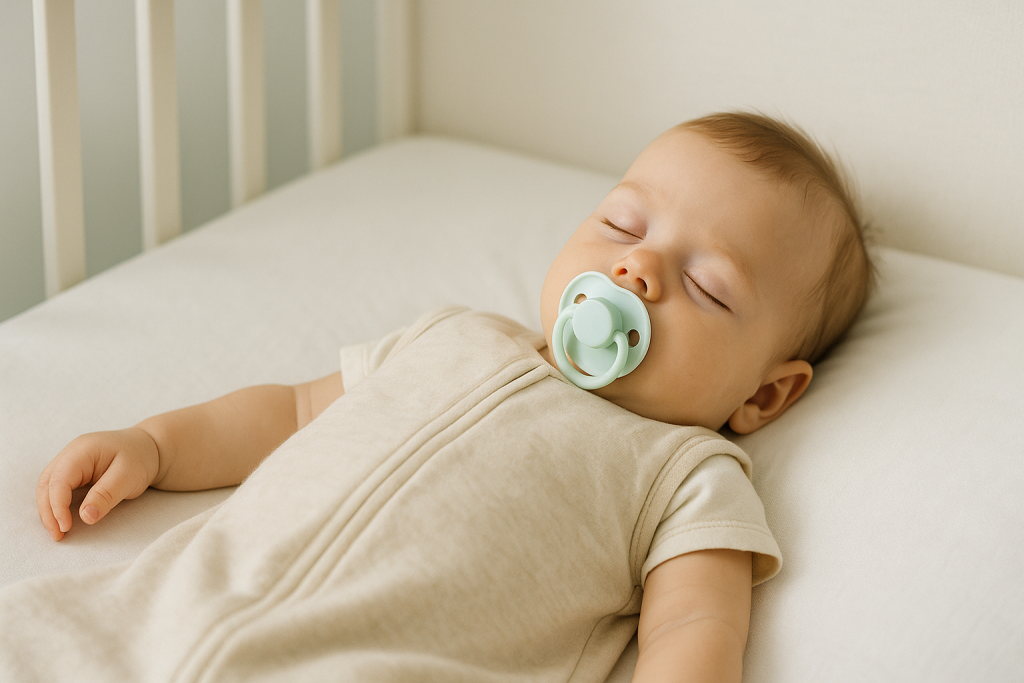
Why Pacifiers May Lower SIDS Risk
We don’t know the exact mechanism, but researchers propose that pacifiers may support airway patency or lighter sleep arousal, which could be protective during a critical developmental window. The recommendation is simple: offer it for sleep; don’t worry if it pops out.
Nighttime Pacifier Safety Checklist (Quick Wins)
- Use a single-piece design (less likely to break) with a sturdy shield (≥1.5 inches) and vent holes.
- No strings, cords, clips, or stuffed toys attached during sleep (strangulation risk).
- Right size for age to reduce choking and improve latch comfort.
- Lay baby on the back on a firm, flat surface; keep the crib empty (no pillows, blankets, or bumpers).
Choosing a Pacifier for Newborn Sleep
Think of fit, feel, and function:
- Age & size: Labels like “0–3m” or “0–6m” matter.
- Material: Medical-grade silicone holds up well and cleans easily.
- Shape: Orthodontic (flattened) vs rounded (nipple-like); some babies clearly prefer one.
- One-piece vs multi-piece: One-piece designs reduce breakage risk.
Will a Pacifier Cause Dental Problems?
Dental effects are more about how long and how often a pacifier is used, especially past toddlerhood. Prolonged use may contribute to issues like overjet or malocclusion; many dentists suggest weaning between 6–12 months or at least by 2–3 years to minimize risk. Your pediatric dentist can personalize advice.
How to Keep the Pacifier Clean (Without Overthinking It)
- Before first use: Sterilize per manufacturer (boiling water or sterilizer).
- Daily: Wash with hot, soapy water; let it air-dry.
- Replace regularly: If it’s cracked, sticky, or thinning, replace it. (Silicone can fatigue with repeated sterilization.)
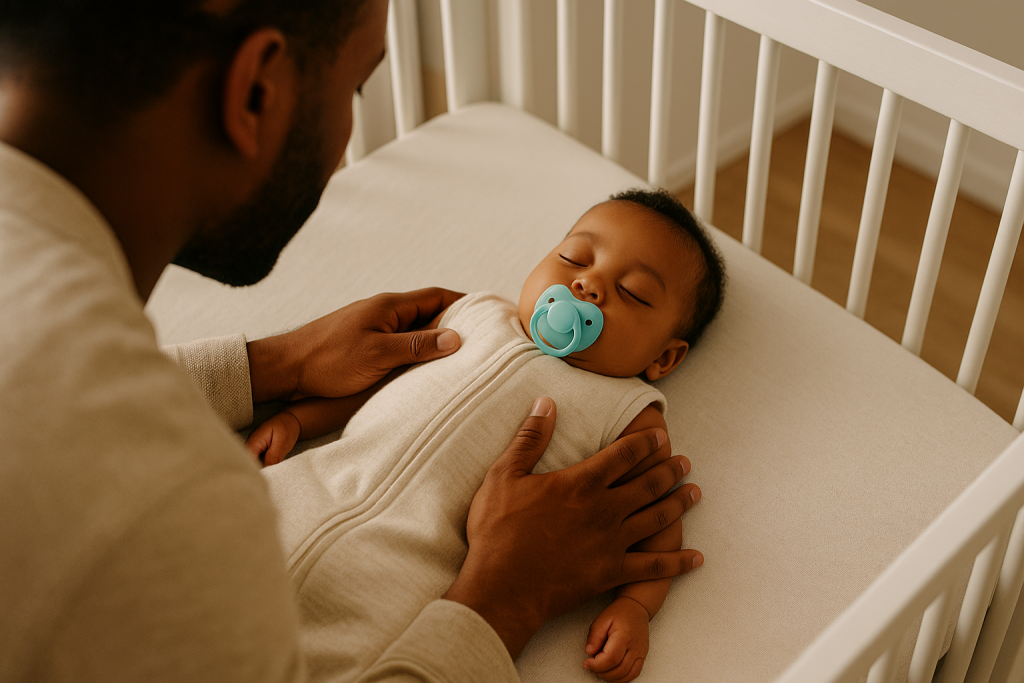
A Gentle Bedtime Flow (So the Pacifier Helps, Not Hinders)
- Feed first, then diaper, then swaddle/sleep sack.
- Dim lights, add white noise, and hold/rock until drowsy.
- Offer the pacifier as baby settles in the crib on their back.
- If it falls out after sleep, don’t reinsert unless baby fully wakes. This helps your little one connect sleep cycles without relying on a constant paci reset.
Special Cases: Preemies, Reflux, and High-Need Soothers
- Preemies: Pacifiers can be soothing and sometimes support non-nutritive sucking in NICU settings; follow your care team’s guidance.
- Refluxy babies: Some parents feel sucking eases discomfort; watch for over-reliance or frequent wake-ups seeking the paci.
- High-need soothers: Consider a lightweight, one-piece silicone design that stays put more easily—and practice gentle “pause” intervals before reinserting at night.
Pacifier Troubleshooting (Because Babies Have Opinions)
- Won’t take it? Try a different shape, warm the tip briefly in warm water, or offer right after a feed when baby is calm.
- Keeps popping out? Check size and angle. A slightly upward angle toward the palate helps some babies.
- Over-reliance? Use the pacifier only for sleep and soothing, not for every fuss. Pair with shushing, swaying, and swaddling to diversify soothing tools.
Myths vs. Facts
- Myth: “Pacifiers always ruin breastfeeding.”
Fact: High-level evidence doesn’t support a causal effect when breastfeeding is established. - Myth: “If it falls out, you must put it back.”
Fact: The SIDS benefit persists even if it falls out; let sleeping babies sleep. - Myth: “Clipping the pacifier keeps it from getting lost at night.”
Fact: Clips, cords, and plush attachments are not safe in the crib.
Amazon Picks: 5 Newborn Pacifiers Worth Considering
1) Philips Avent Soothie 0–3 Months
Why parents like it: The classic hospital-style, one-piece silicone pacifier many newborns accept.
Features: One-piece medical-grade silicone; round nipple; dishwasher safe.
Pros: Soft yet sturdy; widely available; easy to clean.
Cons: Round shape isn’t every baby’s favorite; can be a tad bulky on petite faces.
Best for: Parents who want the tried-and-true “starter” paci.
What reviews often say: Simple, durable, easy to sterilize; many babies take it immediately.
2) MAM Comfort Newborn (One-Piece)
Why parents like it: Lightweight with small shield cutouts for tiny faces.
Features: One-piece silicone; symmetrical nipple; textured surface for grip.
Pros: Very light; stays in better for some babies; orthodontic-minded shape.
Cons: Symmetrical shape isn’t ideal for every latch preference.
Best for: Babies who won’t hold onto denser pacifiers.
Reviews vibe: “Finally one that stays in; baby likes the feel.”
3) Dr. Brown’s HappyPaci (0–6m)
Why parents like it: Soft silicone modeled after Dr. Brown’s bottle nipples (handy for bottle-fed babies).
Features: One-piece silicone; contoured butterfly shield; bottle-nipple-inspired.
Pros: Familiar feel for bottle babies; easy to clean.
Cons: Some breastfed babies don’t love the shape.
Best for: Bottle-feeding families wanting continuity.
Reviews vibe: “Baby recognized it right away; cleaning is painless.”
4) Tommee Tippee Ultra-Light Silicone Pacifier
Why parents like it: Feather-light feel designed to stay put with less effort from baby.
Features: One-piece design; thin curved shield; orthodontic nipple.
Pros: Minimal weight; gentle on cheeks.
Cons: Ultra-light can bounce out for super-active suckers.
Best for: Babies who fight heavier pacifiers.
Reviews vibe: “Doesn’t leave marks; baby keeps it longer.”
5) NUK Sensitive Newborn Pacifier
Why parents like it: Orthodontic nipple with a flexible, soft shield for sensitive skin.
Features: Silicone construction; heart-shaped shield; orthodontic nipple.
Pros: Comfort around the nose; good for smaller faces.
Cons: Shape preference varies; not everyone loves orthodontic profiles.
Best for: Sensitive skin and petite newborns.
Reviews vibe: “No redness; fits our baby’s face nicely.”
Comparison Table: Newborn Pacifiers at a Glance
| Product | Age Range | One-Piece | Nipple Style | Shield Style | Dishwasher Safe |
| Philips Avent Soothie | 0–3m | Yes | Round | Full round | Yes |
| MAM Comfort Newborn | 0–6m | Yes | Symmetrical/orthodontic | Vent cutouts | Yes |
| Dr. Brown’s HappyPaci | 0–6m | Yes | Bottle-like | Butterfly | Yes |
| Tommee Tippee Ultra-Light | 0–6m | Yes | Orthodontic | Curved thin | Yes |
| NUK Sensitive | 0–6m | Primarily one-material | Orthodontic | Heart-shaped | Yes |
Safety reminder: Do not use clips, cords, or plush attachments in the crib. Once your baby is on their back in an empty crib, offer the pacifier.
How to Use Pacifiers as Part of a Healthy Sleep Routine
- Keep pacifier time purposeful—for naps, bedtime, and big soothing moments.
- If baby fully wakes and cries when it falls out, pause, give a hand on the chest or gentle shush first, then decide whether to reinsert.
- As baby matures (around 4–6 months), consider feeding and wake-window tweaks before assuming the pacifier is the root of wake-ups.
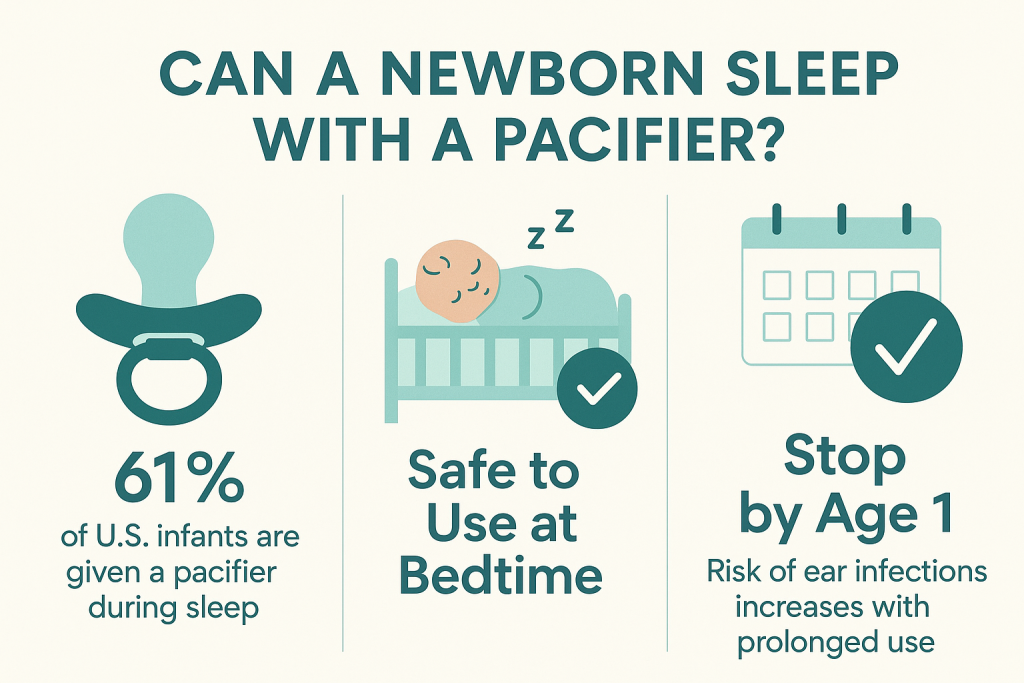
Weaning: When and How to Say Goodbye
Many families begin soft weaning anywhere from 6–12 months, or later if baby still benefits. Try reducing daytime dependence first, then limit to sleep, then phase out bedtime. Celebrate small wins (“You did it without your paci!”) and replace with another comfort (a song, a hand on the chest). For dental and ear-health reasons, avoid long-term, heavy pacifier use into the toddler years.
🧪 Research-Backed Insights (In Plain Language)
1) Pacifiers & SIDS risk
Pediatric policy statements recommend offering a pacifier at naps and bedtime because studies associate pacifier use with a lower SIDS risk. The recommendation stands even if the pacifier falls out. The precise mechanism isn’t fully known; hypotheses include subtle airway positioning and arousal effects. See the AAP’s safe sleep policy and its evidence review for details.
2) Pacifiers & breastfeeding
High-level evidence—including Cochrane reviews—suggests pacifier use does not shorten breastfeeding duration when breastfeeding is otherwise going well. Observational studies that found an association likely reflect pre-existing feeding difficulties rather than the pacifier itself. See summaries in Cochrane and peer-reviewed reviews.
FAQs
Can a newborn sleep with a pacifier all night?
Yes—if the pacifier meets safety guidelines and your baby is placed on their back in a clear sleep space. No need to put it back in if it drops out.
Should I wait to introduce a pacifier if I’m breastfeeding?
Often, yes. Many agencies suggest waiting until breastfeeding is well-established so you can read hunger vs. soothing cues clearly.
Do pacifiers cause dental problems?
Prolonged, heavy use—especially into toddlerhood—can affect bite alignment. Consider gradual weaning in the first couple of years and ask your pediatric dentist for personalized guidance.
Are pacifier clips safe during sleep?
No. Avoid clips, cords, and plush attachments in the crib to eliminate strangulation or suffocation risks.
How can I encourage pacifier use if my baby resists?
Try different shapes or brands, warm the nipple slightly in warm water, and offer when baby is calm and drowsy—not starving or overstimulated.
A Helpful Resource for Gentle Routines
If you want a simple, soothing approach to bedtime rhythms, check out these gentle sleep strategies for little ones on “Go To Sleep” guide.
The Heart-to-Heart Takeaway
You’re doing an amazing job navigating the early weeks. A pacifier isn’t a magic wand—but for many families, it’s a small tool with big comfort. Used within safe-sleep guidelines, it can support soothing and may lower SIDS risk. If you’re breastfeeding, wait until you feel steady, then try it. If your baby loves it, great; if not, that’s okay too. Every family finds its own rhythm.
Tonight, give yourself credit: you’re learning your baby’s language one tiny cue at a time. That’s the real “secret” to newborn sleep.

